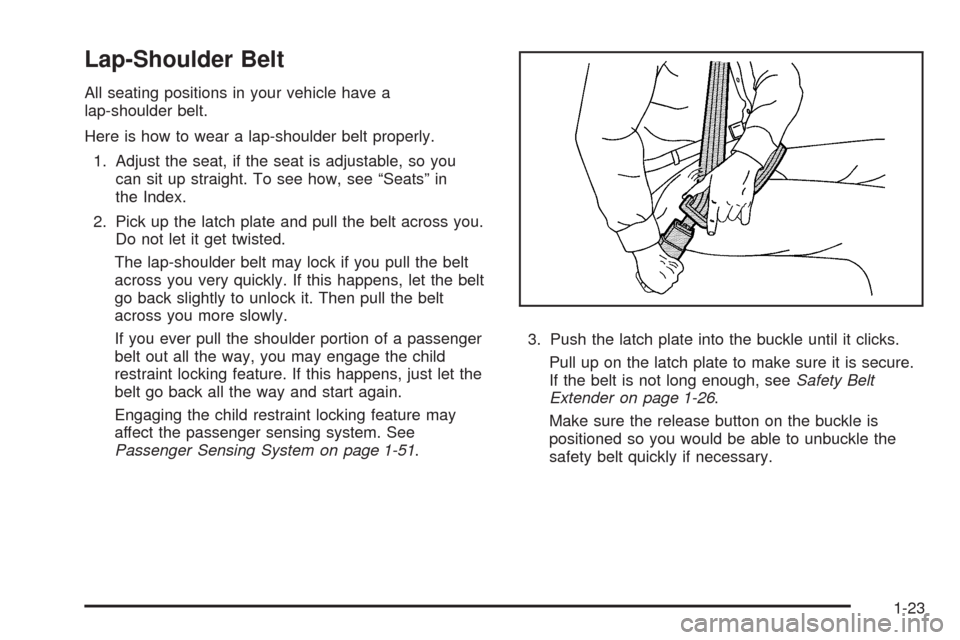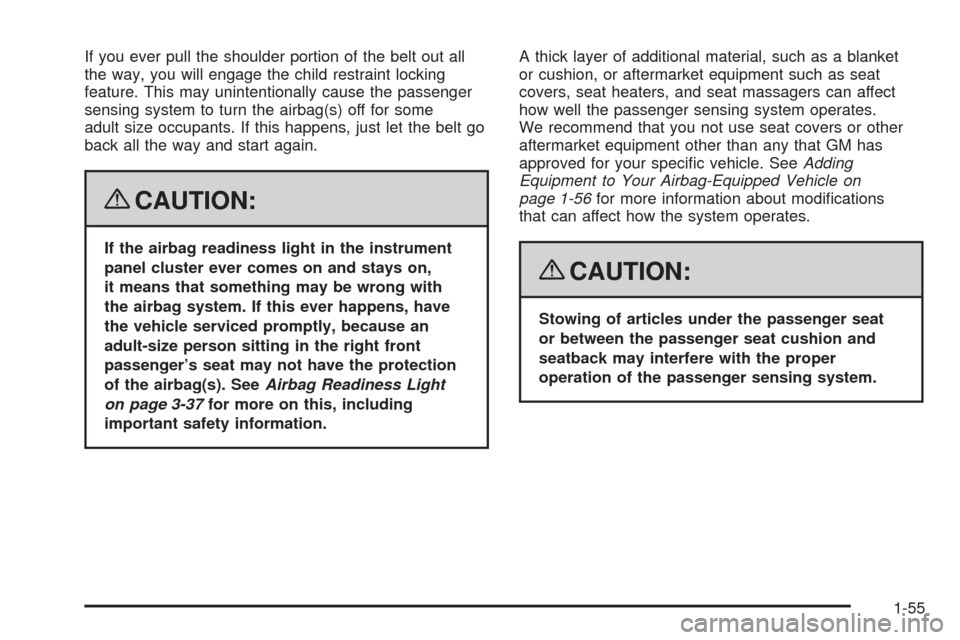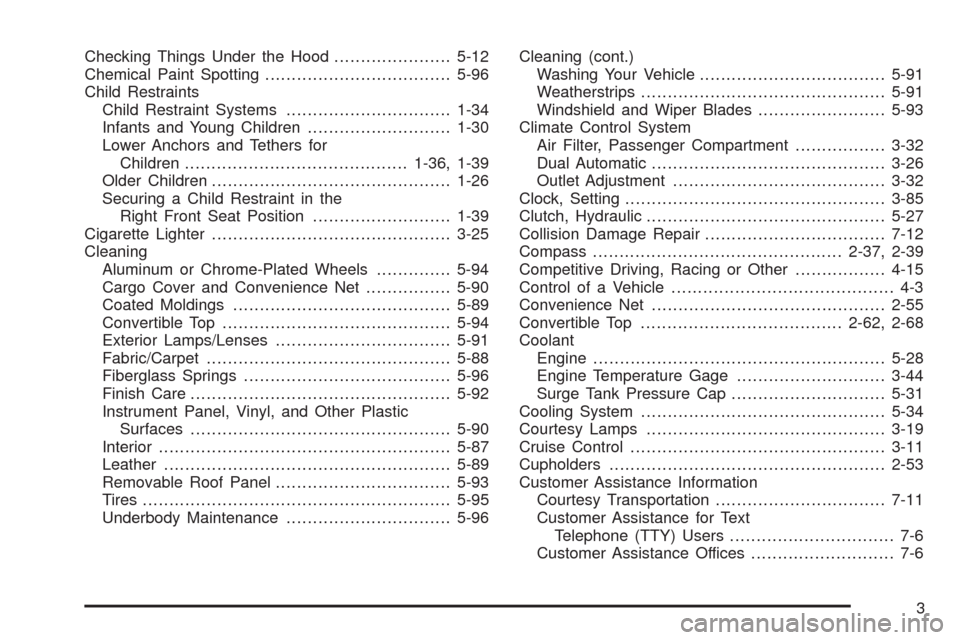2008 CHEVROLET CORVETTE child lock
[x] Cancel search: child lockPage 1 of 432

Seats and Restraint Systems........................... 1-1
Front Seats
............................................... 1-2
Safety Belts
.............................................. 1-9
Child Restraints
.......................................1-26
Airbag System
.........................................1-43
Restraint System Check
............................1-58
Features and Controls..................................... 2-1
Keys
........................................................ 2-3
Doors and Locks
......................................2-10
Windows
.................................................2-16
Theft-Deterrent Systems
............................2-18
Starting and Operating Your Vehicle
...........2-21
Mirrors
....................................................2-37
OnStar
®System
......................................2-43
Universal Home Remote System
................2-46
Storage Areas
.........................................2-53
Roof Panel
..............................................2-57
Convertible Top
.......................................2-62
Instrument Panel............................................. 3-1
Instrument Panel Overview
.......................... 3-4
Climate Controls
......................................3-26
Warning Lights, Gages, and Indicators
........3-34
Driver Information Center (DIC)
..................3-51
Audio System(s)
.......................................3-84Driving Your Vehicle....................................... 4-1
Your Driving, the Road, and the Vehicle
....... 4-2
Towing
...................................................4-29
Service and Appearance Care.......................... 5-1
Service
..................................................... 5-3
Fuel
......................................................... 5-5
Checking Things Under the Hood
...............5-12
Rear Axle
...............................................5-51
Headlamp Aiming
.....................................5-51
Bulb Replacement
....................................5-52
Windshield Replacement
...........................5-55
Windshield Wiper Blade Replacement
.........5-55
Tires
......................................................5-58
Appearance Care
.....................................5-87
Vehicle Identi�cation
.................................5-98
Electrical System
......................................5-99
Capacities and Speci�cations
...................5-107
Maintenance Schedule..................................... 6-1
Maintenance Schedule
................................ 6-2
Customer Assistance Information.................... 7-1
Customer Assistance and Information
........... 7-2
Reporting Safety Defects
...........................7-16
Vehicle Data Recording and Privacy
...........7-18
Index................................................................ 1
2008 Chevrolet Corvette Owner ManualM
Page 27 of 432

Lap-Shoulder Belt
All seating positions in your vehicle have a
lap-shoulder belt.
Here is how to wear a lap-shoulder belt properly.
1. Adjust the seat, if the seat is adjustable, so you
can sit up straight. To see how, see “Seats” in
the Index.
2. Pick up the latch plate and pull the belt across you.
Do not let it get twisted.
The lap-shoulder belt may lock if you pull the belt
across you very quickly. If this happens, let the belt
go back slightly to unlock it. Then pull the belt
across you more slowly.
If you ever pull the shoulder portion of a passenger
belt out all the way, you may engage the child
restraint locking feature. If this happens, just let the
belt go back all the way and start again.
Engaging the child restraint locking feature may
affect the passenger sensing system. See
Passenger Sensing System on page 1-51.3. Push the latch plate into the buckle until it clicks.
Pull up on the latch plate to make sure it is secure.
If the belt is not long enough, seeSafety Belt
Extender on page 1-26.
Make sure the release button on the buckle is
positioned so you would be able to unbuckle the
safety belt quickly if necessary.
1-23
Page 46 of 432

5. Pull the rest of the shoulder belt all the way out of
the retractor to set the lock.6. To tighten the belt, push down on the child restraint,
pull the shoulder portion of the belt to tighten the
lap portion of the belt and feed the shoulder
belt back into the retractor. If you are using a
forward-facing child restraint, you may �nd it helpful
to use your knee to push down on the child
restraint as you tighten the belt.
1-42
Page 59 of 432

If you ever pull the shoulder portion of the belt out all
the way, you will engage the child restraint locking
feature. This may unintentionally cause the passenger
sensing system to turn the airbag(s) off for some
adult size occupants. If this happens, just let the belt go
back all the way and start again.
{CAUTION:
If the airbag readiness light in the instrument
panel cluster ever comes on and stays on,
it means that something may be wrong with
the airbag system. If this ever happens, have
the vehicle serviced promptly, because an
adult-size person sitting in the right front
passenger’s seat may not have the protection
of the airbag(s). SeeAirbag Readiness Light
on page 3-37for more on this, including
important safety information.A thick layer of additional material, such as a blanket
or cushion, or aftermarket equipment such as seat
covers, seat heaters, and seat massagers can affect
how well the passenger sensing system operates.
We recommend that you not use seat covers or other
aftermarket equipment other than any that GM has
approved for your speci�c vehicle. SeeAdding
Equipment to Your Airbag-Equipped Vehicle on
page 1-56for more information about modi�cations
that can affect how the system operates.
{CAUTION:
Stowing of articles under the passenger seat
or between the passenger seat cushion and
seatback may interfere with the proper
operation of the passenger sensing system.
1-55
Page 74 of 432

Doors and Locks
Door Locks
{CAUTION:
Unlocked doors can be dangerous.
Passengers — especially children — can
easily open the doors and fall out of a
moving vehicle. When a door is locked it
will not open. You increase the chance of
being thrown out of the vehicle in a crash
if the doors are not locked. So, wear safety
belts properly and lock the doors
whenever you drive.
Young children who get into unlocked
vehicles may be unable to get out. A child
can be overcome by extreme heat and can
suffer permanent injuries or even death
from heat stroke. Always lock your vehicle
whenever you leave it.
Outsiders can easily enter through an
unlocked door when you slow down or
stop your vehicle. Locking your doors
can help prevent this from happening.There are several ways to lock and unlock your vehicle.
From the outside, press the lock or unlock button on
the keyless access transmitter.
When you have the transmitter with you, you may also
unlock and open the door by squeezing the door
handle sensor (A). You do not have to press the unlock
button on the transmitter. You will be able to open
the door when you press the door handle sensor and
the vehicle recognizes your keyless access transmitter.
When the passenger door is opened �rst, the driver’s
door will also unlock.Door Open to Show Location of Door Handle Sensor
2-10
Page 254 of 432

Steering in Emergencies
There are times when steering can be more effective
than braking. For example, you come over a hill and �nd
a truck stopped in your lane, or a car suddenly pulls out
from nowhere, or a child darts out from between parked
cars and stops right in front of you. You can avoid these
problems by braking — if you can stop in time. But
sometimes you cannot; there is not room. That is the time
for evasive action — steering around the problem.
Your vehicle can perform very well in emergencies like
these. First apply the brakes. SeeBraking on page 4-4.
It is better to remove as much speed as you can from a
possible collision. Then steer around the problem, to the
left or right depending on the space available.
An emergency like this requires close attention and a
quick decision. If you are holding the steering wheel at
the recommended 9 and 3 o’clock positions, you
can turn it a full 180 degrees very quickly without
removing either hand. But you have to act fast, steer
quickly, and just as quickly straighten the wheel
once you have avoided the object.
The fact that such emergency situations are always
possible is a good reason to practice defensive driving
at all times and wear safety belts properly.
4-12
Page 421 of 432

Checking Things Under the Hood......................5-12
Chemical Paint Spotting...................................5-96
Child Restraints
Child Restraint Systems...............................1-34
Infants and Young Children...........................1-30
Lower Anchors and Tethers for
Children..........................................1-36, 1-39
Older Children.............................................1-26
Securing a Child Restraint in the
Right Front Seat Position..........................1-39
Cigarette Lighter.............................................3-25
Cleaning
Aluminum or Chrome-Plated Wheels..............5-94
Cargo Cover and Convenience Net................5-90
Coated Moldings.........................................5-89
Convertible Top...........................................5-94
Exterior Lamps/Lenses.................................5-91
Fabric/Carpet..............................................5-88
Fiberglass Springs.......................................5-96
Finish Care.................................................5-92
Instrument Panel, Vinyl, and Other Plastic
Surfaces.................................................5-90
Interior.......................................................5-87
Leather......................................................5-89
Removable Roof Panel.................................5-93
Tires..........................................................5-95
Underbody Maintenance...............................5-96Cleaning (cont.)
Washing Your Vehicle...................................5-91
Weatherstrips..............................................5-91
Windshield and Wiper Blades........................5-93
Climate Control System
Air Filter, Passenger Compartment.................3-32
Dual Automatic............................................3-26
Outlet Adjustment........................................3-32
Clock, Setting.................................................3-85
Clutch, Hydraulic.............................................5-27
Collision Damage Repair..................................7-12
Compass
...............................................2-37, 2-39
Competitive Driving, Racing or Other.................4-15
Control of a Vehicle.......................................... 4-3
Convenience Net............................................2-55
Convertible Top......................................2-62, 2-68
Coolant
Engine.......................................................5-28
Engine Temperature Gage............................3-44
Surge Tank Pressure Cap.............................5-31
Cooling System..............................................5-34
Courtesy Lamps.............................................3-19
Cruise Control................................................3-11
Cupholders....................................................2-53
Customer Assistance Information
Courtesy Transportation................................7-11
Customer Assistance for Text
Telephone (TTY) Users............................... 7-6
Customer Assistance Offices........................... 7-6
3
Page 425 of 432

In�ation - Tire Pressure...................................5-66
Installing the Roof Panel..................................2-60
Instrument Panel
Brightness..................................................3-19
Cluster.......................................................3-35
Overview..................................................... 3-4
J
Jump Starting.................................................5-46
K
Keyless Access System..................................... 2-5
Keyless Access System, Operation...................... 2-6
Keys............................................................... 2-3
L
Labeling, Tire Sidewall.....................................5-60
Lamps
Courtesy....................................................3-19
Exterior Lighting Battery Saver......................3-19
Reading.....................................................3-20
Twilight Sentinel
®........................................3-18
Lap-Shoulder Belt...........................................1-23LATCH System
Child Restraints...................................1-36, 1-39
Latches, Seatback............................................ 1-8
Lifting the Vehicle, Tires...................................5-81
Light
Active Handling System................................3-43
Airbag Readiness........................................3-37
Anti-lock Brake System (ABS) Warning...........3-42
Brake System Warning.................................3-41
Fog Lamp ..................................................3-49
Highbeam On.............................................3-50
Lights On Reminder.....................................3-50
Malfunction Indicator....................................3-45
One-to-Four Shift.........................................3-40
Passenger Airbag Status Indicator..................3-38
Safety Belt Reminders..................................3-36
Security.....................................................3-49
TCS Warning Light......................................3-42
Tire Pressure..............................................3-44
Traction Control System (TCS) Warning..........3-42
Lighting
Entry/Exit...................................................3-19
Lights
Exterior Lamps............................................3-15
Flash-to-Pass..............................................3-10
High/Low Beam Changer................................ 3-9
On Reminder..............................................3-16
7